Microsoft Surface Pro 3 Review
by Anand Lal Shimpi on June 23, 2014 3:55 AM EST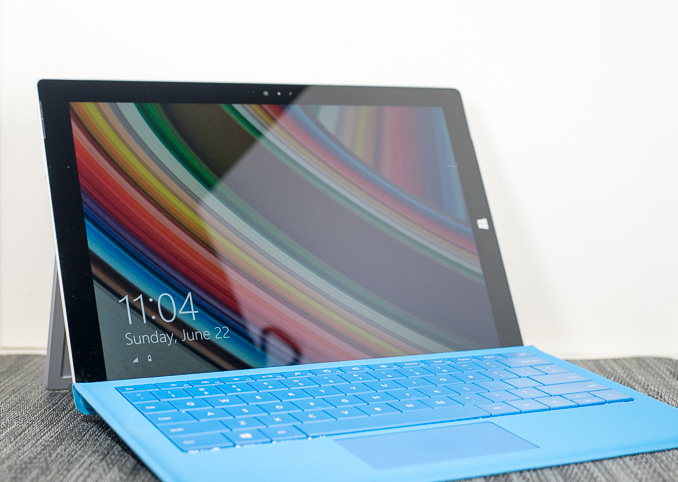
I can't believe it's only been sixteen months since I published our review of the original Microsoft Surface Pro. It feels like longer but that's likely because Surface RT made its sale debut a few months prior to that, and both devices were announced in the Summer of 2012. As far as an end user is concerned however, in February 2013 Microsoft released Surface Pro and proceeded to deliver two more iterations of the hardware in sixteen months. That's three Surface Pros in less than two years.
While the last two were largely similar, the third time is definitely more charming. Surface Pro 3 abandon's Microsoft's 10.6-inch 16:9 form factor in favor of 12-inch 3:2 design. The result is a far less cramped design, and one that does a better job of approximating a normal laptop. To offset the increase in surface area, Surface Pro 3 goes on a substantial diet and shrinks to only 9.1mm thick. Despite using the same SoC as Surface Pro 2, the 3rd generation device is substantially thinner.
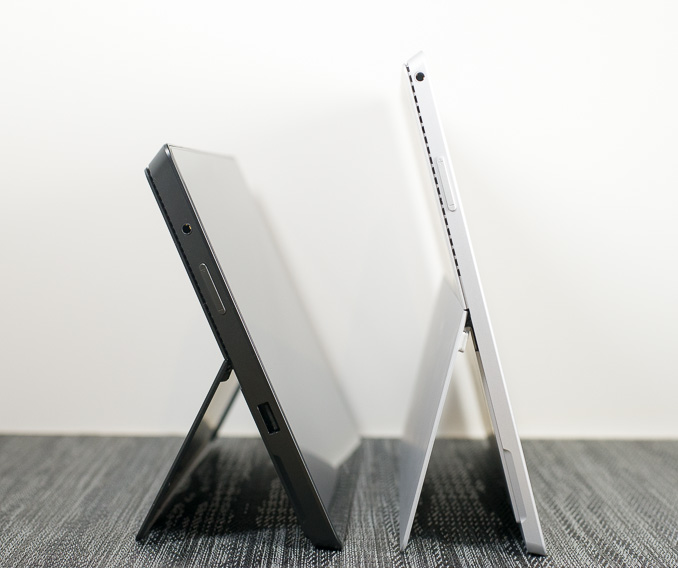
Surface Pro 2 (left) vs. Surface Pro 3 (right)
When Surface first launched, Microsoft set out to prove to the world that it too could build a thoughtfully designed, premium device. Much was said about Microsoft's custom injection moulded Magnesium process, VaporMg, and the extensive testing of the Surface kickstand and hinge. The latter was said to be able to last for over a million actuations.
Surface Pro 3 retains all of the build quality goodness that made the previous designs so unique in the Windows space. The chassis is still made out of Magnesium (although Microsoft curiously has dropped the term VaporMg), and now features the same lighter finish as Surface 2. The design is far more squared off than what we're used to seeing from Apple or any of Google's partners. Surface Pro 3 continues the line's tradition of exuding a more utilitarian design than the softer, more consumption (and consumer?) oriented tablet designs on the market.
| Microsoft Surface Pro Comparison | |||||||||
| Surface Pro 3 | Surface Pro 2 | Surface Pro | |||||||
| Dimensions | 11.5 x 7.93 x 0.36" | 10.81 x 6.81 x 0.53" | 10.81 x 6.81 x 0.53" | ||||||
| Display | 12-inch 2160 x 1440 | 10.6-inch 1920 x 1080 w/ Improved Color Accuracy | 10.6-inch 1920 x 1080 PLS | ||||||
| Weight | 1.76 lbs | 2.0 lbs | 2.0 lbs | ||||||
| Processor | As Configured: Core i5-4300U with HD4400 Graphics (15W Haswell ULT) - Optional Core i3 or Core i7 | Core i5-4200U/4300U with HD4400 Graphics (15W Haswell ULT) | Core i5-3317U with HD4000 Graphics (17W Ivy Bridge) | ||||||
| Cameras | 5MP/5MP (front/rear) | 1.2MP/1.2MP (front/rear) | 1.2MP/1.2MP (front/rear) | ||||||
| Connectivity | 2-stream 802.11ac WiFi | 2-stream 802.11n WiFi | 2-stream 802.11n WiFi | ||||||
| Memory | 4GB or 8GB LPDDR3 | 4GB or 8GB LPDDR3 | 4GB | ||||||
| Storage | 64, 128, 256 or 512GB |
64 or 128GB (4GB RAM) 256GB or 512GB (8GB RAM) |
64GB or 128GB | ||||||
| Battery | 42.0 Wh | 42.0 Wh | 42.0 Wh | ||||||
| Starting Price | $799 ($1299 review configuration) | $899 | $799 | ||||||
Other than the chassis upgrade, there are now more CPU options with the base model starting at $799:
| Microsoft Surface Pro 3 Configuration Options | |||||||||||
| Configuration | $799 | $999 | $1299 | $1549 | $1949 | ||||||
| CPU | Intel Core i3-4020Y | Intel Core i5-4300U | Intel Core i5-4300U | Intel Core i7-4650U | Intel Core i7-4650U | ||||||
| TDP | 11.5W | 15W | 15W | 15W | 15W | ||||||
| Cores/Threads | 2/4 | 2/4 | 2/4 | 2/4 | 2/4 | ||||||
| Frequency Base/Max Turbo | 1.5GHz/- | 1.9/2.9GHz | 1.9/2.9GHz | 1.7/3.3GHz | 1.7/3.3GHz | ||||||
| GPU | Intel HD 4200 | Intel HD 4400 | Intel HD 4400 | Intel HD 5000 | Intel HD 5000 | ||||||
| GPU EUs | 20 | 20 | 20 | 40 | 40 | ||||||
| GPU Frequency Base/Max Turbo | 200/850MHz | 200/1100MHz | 200/1100MHz | 200/1100MHz | 200/1100MHz | ||||||
| Storage | 64GB SSD | 128GB SSD | 256GB SSD | 256GB SSD | 512GB SSD | ||||||
| RAM | 4GB | 4GB | 8GB | 8GB | 8GB | ||||||
The Kickstand: Perfected
From the moment I first used Surface RT, I fell in love with its kickstand. In fact, I went as far as as to say that it was one of the most useful features to ever meet a tablet. The original kickstand was great for desk use. The second generation kickstand added a second stop to improve usability in non-desktop (read: lap-bound) scenarios. With each generation, Microsoft improved its kickstand by adding in the one thing we asked for the last round. With Surface Pro 3, Microsoft perfected the kickstand.
The default opening is still 22-degrees, and the process of getting it open is just as easy as it was before. After you hit that initial stop however, friction in the hinge increases dramatically and with a bit more effort you can push and set the kickstand to any other opening between 22 and 150 degrees. The increased flexibility gives Surface Pro 3 the best kickstand implementation I've seen on any mobile device. Not only can I find a more comfortable position for notebook use, but I can also put the device into tent mode which is great for browser and other tablet workloads. In tent mode Surface Pro 3 is the most comfortable tablet I've ever used.
Lapability
For as much criticism as Microsoft received over Windows 8 and Surface, the company bet big on fixing one of the biggest unsolved problems in mobile. Tablets and notebooks are both great, wouldn't it be amazing if someone could converge the two. Given Microsoft's relative inaction in mobile for the years prior to Windows 8, attempting to leapfrog the market was a very sensible thing to do.
Surface Pro in particular running Windows 8 was designed to be the Swiss Army Knife of mobile computing devices. Whether you wanted a tablet, laptop or even a desktop, Microsoft had a single device it could sell you to serve all three functions. In reality however, Surface always ended up a series of compromises that never seemed to work for the masses. Windows 8 was a disappointment as a tablet OS, and Surface didn't quite work as a laptop, specifically in one's lap. Microsoft referred to the inability for the prior hardware to function ergonomically in the lap as "lapability".
To understand how Surface Pro 3 changed mechanically in pursuit of better "lapability", we need to first understand the difficulties faced by all of the previous Surface designs (Surface RT, Surface Pro, Surface 2 and Surface Pro 2).
The challenge with the Surface design has always been the amount of room it requires on your lap. While you only need to accommodate the room behind the keyboard on a normal laptop, a Surface device requires that much room plus a contact point for the outer edge of the kickstand. At narrow angles, this amounts to another couple inches of lap-room. However, the kickstand opened at a narrow angle forces a less natural display viewing angle. Open the kickstand wider, a feature enabled by Surface Pro 2 (and furthered by Surface Pro 3) and you address the viewing angle concern at the expense of now requiring more room on your lap. You can always pull the device closer to you to compensate, but then you end up sacrificing typing position/comfort.
There's also the issue of stability on your lap. Traditional laptops have a rigid base supporting the device. The Surface devices, on the other hand, don't. The strongest, most rigid part of Surface is the display, which needs but doesn't give much support. Instead the stability duties come from the small contact point of the kickstand and the Type Cover. The Type Cover itself is quite rigid, but the flexible hinge between it and the Surface device was a clear weakspot. In order to allow the Type Cover to function as a cover, its hinge couldn't be totally rigid - it needed to be able to fold around the spine of the tablet. In doing so you get an incredibly useful cover, but a weakened base for using a Surface tablet as a notebook on your lap.
With Surface Pro 3, Microsoft managed to largely address the stability issue and in doing so somewhat addressed the lap-space requirement. The new Type Cover has a second magnetic strip in it that allows you to fold it in even closer to the display when you're in laptop-mode. Doing so completely occludes the bottom bezel, but it eliminates the floppy cover spine from resting on your lap. Now the only parts of the device touching your lap in laptop-mode are rigid elements, which tremendously improves the stability of the design.
As a side effect, by shortening the length of the cover in laptop-mode Microsoft reduces the amount of lap room needed by about an inch. It's not perfect, but it goes a long way to making Surface Pro 3 actually usable on your lap.
The design continues to be a tradeoff however. The new, continuously adjustable kickstand lets you maintain a better viewing angle by opening to wider angles, which require correspondingly more lap area. While the new Type Cover takes up less room, the wider angled kickstand can negate a lot of those savings. The net result is still an ergonomic improvement though. Surface Pro 3 is much easier to position properly on my lap compared to any previous Surface device. While the latter were all ultimately a pain to use on my lap, Surface Pro 3 is passable. I still prefer a laptop, but the gap has been narrowed considerably.
The only other issue that remains with the new foldable Type Cover hinge is the occlusion of the lower bezel on the display. Windows 8 was built around edge gestures, where a swipe in from a bezel would bring up a task switcher, the charms bar or an application-specific menu. By covering the bottom bezel you can no longer use it for edge gestures within an application. Thankfully the top bezel serves the same purpose, but it does require a longer reach than going for the bottom one - something I'd grown used to doing on previous Surface tablets. The occluded bottom bezel forced the relocation of the capacitive Start button to the right side of the panel, which can create issues with accidentally bringing up the Start Screen.


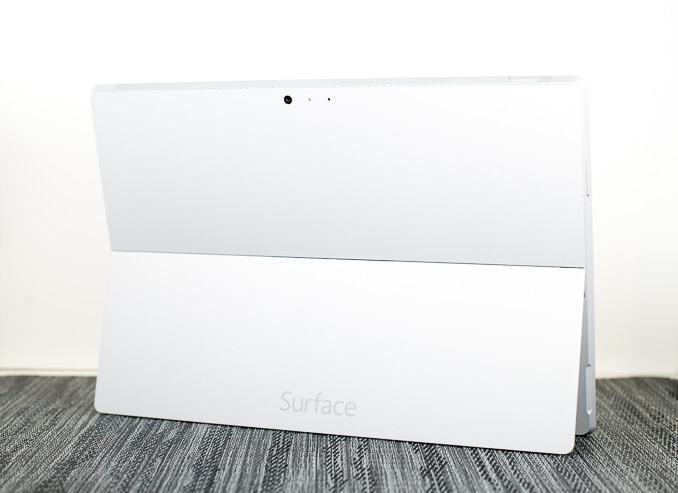
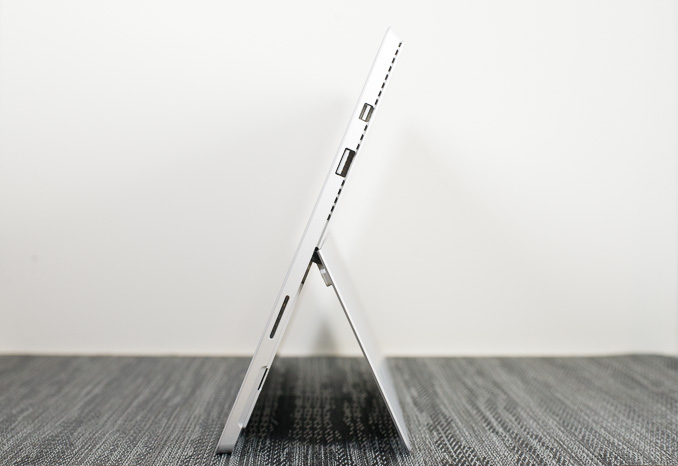
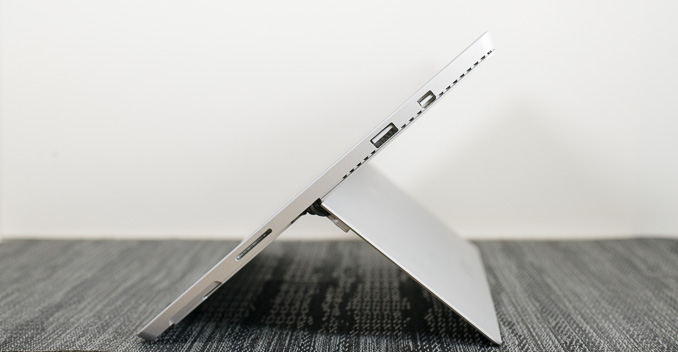

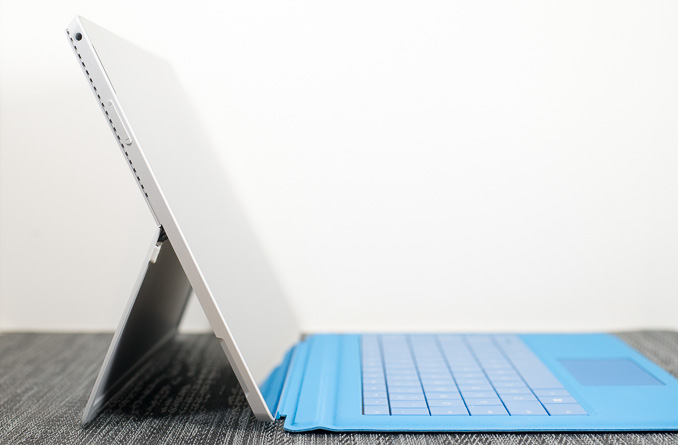
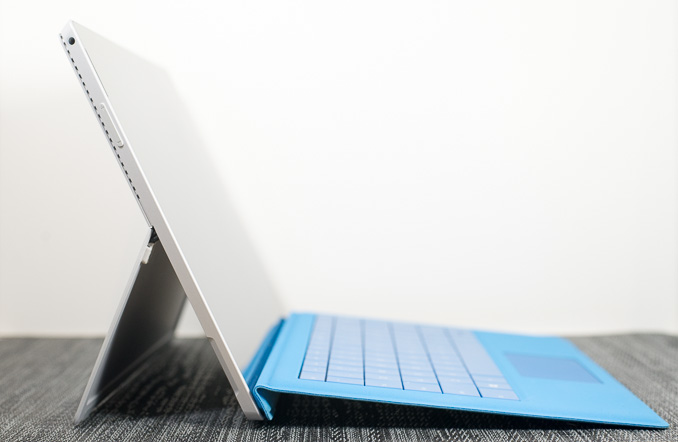








274 Comments
View All Comments
Morawka - Monday, June 23, 2014 - link
Wow SP3's Sata SSD is hanging Neck and Neck with the MBA's PCIe Based SSD. just crazycarljoseph - Monday, June 23, 2014 - link
Pretty good review. If anyone wants to get their hands on a Surface Pro 3, some folks I work for are giving a couple away in a competition. https://msgooroo.com/surfacecompkhanov - Monday, June 23, 2014 - link
Surface Pro 3 costs as much as a well specced laptop. Any decent laptop has a user replaceable battery, and many people that own laptops have replaced the battery at some point, as they generally only last a few years at best.I can't see myself spending all that money on Surface Pro 3 then throwing the whole device out just because the battery has failed a few years later. In this price bracket, Redmond need to address this issue.
nerd1 - Monday, June 23, 2014 - link
Eh... none of apple laptops have user replaceable battery nowadays.drunken - Monday, June 23, 2014 - link
I got my SP3 on Friday, so far I love it. For my use case the SP3 is perfect - productivity/development work at home and the office (visual studio, sql server, office). I'll be getting 2 docking stations when they come out for a full desktop-like setup.If I'm out and about and need to do some fixes or minor work, then the portability and capabilities of the SP3 is perfect. It's not great to use on a lap but I could definitely make do for short periods of time.
I installed a start menu which makes it function basically like Windows Pro 7. My "real work" is done in desktop mode - no need to open any apps in Metro mode.
So far I have only used at as a tablet for consumption/games in bed or on the couch. The Netflix app is great. It is a bit heavy for a tablet but I'm willing to have that slight trade-off for the 2 in 1 package. I'm really trying to use it as two different devices.
beyondabraxas - Monday, June 23, 2014 - link
What about the glued in components/built in obsolescence/ impossibility to repair?I have a story for ya'll....
I dropped my SP1, barely 15 inches onto thick and fluffy carpet, thing is, it landed on the kickstand, and the kickstand tore off, when it did tear off -- thanks to the over gluing inside, the tabs of the kickstand peeled off some other black foil like stuff, which I'm assuming was battery related since after that I'd notice kinds of 'powder' and 'sweat' which would burn with my hands - I called M$ - since it was still under warranty, However, they wouldn't fix it for me since it was considered my fault for dropping it, which I'm totally fine with, losing a kick stand, no problem, my fault for that -- whats not my fault is the kickstand being so flimsy and attached to glue inside that it would peel stuff off, thats a product problem. The kickstand can be very easy to break off, if you do, you can be boned like I was. Anyways, I had to pay $300 (in goodfaith) for a refurb exchange two months ago, in this time, they're 'supposed to be' inspecting my device to verify my claims, thats the best they could do apparently - So far, I've heard nada - And this Refurb has been a shit experience all over again, since I'm assuming the battery in the refurb wasn't replaced, and has been giving me all kinds of hassle. Its been weaker than my old surface, I've spent hours trouble shooting with support on the phone, trying to solve the 'Plugged in - Not Charging' message I'm constantly faced with - The techs determined I should send it back in for another Refurb. I say fuck that - The amount of time and headache sunk into this thing is not worth it - Once mine dies, it dies - And I'm done with Surface thanks to their shoddy construction i.e. use of glue/built in obsoletion. I'd rather get a competitors product that allows me to atleast change the battery on my $1000+ device.
I really was one of the initial proponents of this device - My friend, an animation director was an early adopter and promoter, he was supposed to do commercials with them for it, not sure what happened to that - So he turned me onto this thing, I was all about it, its (was) the perfect device for an animator/artist. Now, this whole experience with battery related stuff has left such a bad taste that I'm done with this product line. Microsoft has had a history with shoddy electronics. Like my old Xbox360(s) RODing repeatedly. Screw supporting local american brands if thats the kind of build quality one can expect.
iFixit rightfully gave the Surfaces a repairability score of 1/10. Its non existant. All batteries die eventually - IQ or not. I gotta deal with my soon to be $1300 paperweight.
Sorry for rant - I've been a subscriber and follower of this sub for too long, contributer in its early days - now I just hate hearing about surface stuff considering my shitty experiences.
I know my post is about the SP1 - you can bet the SP3 is no different. They're annual products with no chance of repairability.
Gigaplex - Monday, June 23, 2014 - link
"While the Surface Pro 2 was never quite all that comfortable to use as a laptop, Surface Pro 3's display makes it substantially more laptop-like."Except that the old 16:9 aspect ratio matches most laptops. I've never seen a 3:2 aspect ratio laptop.
nerd1 - Monday, June 23, 2014 - link
16:9 is only good for watching videos, and for productivity task vertical space matters most. Due to the 3:2 aspect ratio, SP3 is easily on par with 13.3" laptops (It has slightly taller screen than 16:10 apple laptops BTW)seapeople - Monday, June 23, 2014 - link
Everything in the review was good, but it seems a bit clipped. For example, based on the specs, one of the big upgrades for the Surface Pro 3 was the camera. Considering that the camera is an important aspect of a tablet it would be nice to have it included in the review.Next, I know you hinted that recover from standby is long, but what about boot times, or hibernate?
What about real life multitasking? Can I watch a you tube video on half the screen and work on excel on the other half, or does this stretch the thermal limits? Sometimes it's hard to tell what running Pcmark42x means in real life.
Again, I think the review was good, but it didn't really go above and beyond, so to say.
MarcSP - Tuesday, June 24, 2014 - link
Totally agree on the camera. Why do not compare it to the rear camera of the MBA13? Oh, wait! :PSeriously, it would be good to have a few paragraphs about the cameras, as well as about the new speakers.